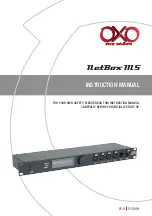
Creating and Downloading a Logo
Page D-8
Reference Guide: EN8000 MPEG-4 Part 10 (H.264/AVC) Encoders
ST.RE.E10233.1
Editing the Palette
The palette may be displayed alongside the image by clicking the
Show/Hide Palette
toolbar
button. The transparency of each palette entry may be altered in the same way as the image
itself, using the left and right mouse buttons. Changes to the palette are shown immediately
on the image.
The Red, Green, Blue and Mix component of the pixel or palette entry under the cursor can be
seen on the status bar at the bottom of the screen.
Palette Reallocation
When the level of transparency of a pixel in the image is changed, a new colour is effectively
created. Whenever the image is downsampled or saved, the palette is rebuilt to reflect the
actual colours in the image. As part of this process, pixels which have a mix value of zero are
mapped to palette entry zero, which is defined as Red = Green = Blue = Mix = 0. The original
colour information is lost and the right mouse button will not change the pixel back to its
original colour.
To rebuild the palette during editing, click the
Reallocate Palette
toolbar button.
D.5.4 Downsampling
Click the
Downsample
toolbar button. A dialog box appears asking for a downsampling ratio.
This can be specified directly, or by entering the desired image size. Click OK to downsample
the image. The downsampling algorithm includes a filter, so the boundary between the active
and inactive areas softens slightly. Zoom in and check that the correct areas are transparent,
and make corrections if necessary.
NOTE…
Once the image has been downsampled, the process cannot be reversed to change the image back to
its original size.
D.5.5
Saving the .osd File
Select
File/Save As/OSD file
from the menu. Saving is possible at any time, and it is
advisable to save the image often while editing is in progress. The file may also be saved in
.bmp format, but this file will not contain transparency information.
















































